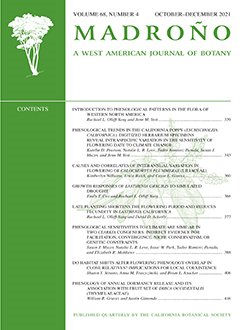I am pleased to report the publication of Madroño volume 68 by the California Botanical Society for 2021.
In my fourth year editing Madroño, I have attempted to keep Madroño at the leading edge of peer reviewed, scientific publications in natural history. Highlights from this past year include publishing 28 full-length Contents articles (our second year in a row of geometric growth), eight Noteworthy Collections (up from five last year), two Book Reviews, and three manuscripts describing New Species. Volume 68 was particularly unique in that it included two Special Issues: “Contributions Toward a Bryoflora of California (and the West), Part V” and “Phenological Patterns in the Flora of Western North America.”
In Part V of the “Bryoflora” series, Guest Editor extraordinaire Jim Shevock recruited 12 authors from a range of academic and professional backgrounds, motivated, encouraged, cajoled, bribed, and succeeded in securing six Bryofloras from California, the Pacific Northwest and Wyoming. His reach is so broad, we had to retitle the Bryoflora Special Issue by adding “(and the West)”. His leadership, never-ending encouragement, timely reminders, and dedication to perfection shepherded these six manuscripts from mere spores to the mature gametophytes they became in Madroño 68(3). At ∼200 pages including numerous color plates, extensive checklists, and a thoughtful introduction by Jim, I was sure that this was going to be one of the largest Madroño issues I had ever edited. I was wrong.
Phenology is hot! Drs. Rachael Olliff Yang (UC Berkeley) and Jen Yost (Cal Poly) offered to Guest Edit a Special Issue on phenological studies of western plants. The final issue of 2021 consists of 14 Contents (more than we had in all four issues combined last year) and is expected to weigh in at over 200 pages. In this issue, Rachael and Jenn have elevated Madroño to a new level of academic rigor by recruiting cutting-edge studies from both established and budding botanists investigating phenology of western North American plants. The results are startling. . .wherever (and however) you look, most western plants bare the phenological footprints of climate change past and present. We anticipate these studies to be of interest to botanists, ecologists, evolutionary biologists, and climate scientists near and far.
It takes a village to publish Madroño. We are grateful for the efforts of 63 distinct reviewers of manuscripts in 2021 (twice as many as last year). We have been actively recruiting reviewers from increasingly diverse backgrounds to elevate the rigor of Madroño. We are increasingly relying on the expertise of botanists from several governmental agencies and private consulting firms in the review process. Along these lines, we have also sought the fresh perspectives students (often in collaboration with their advisors) for reviews. I am especially grateful to reviewers who take the time to truly understand the manuscripts and provide honest, yet constructive feedback to improve the work allowing Madroño to maintain its scientific rigor and preeminence among the journals publishing western natural history science. If you are reading this and wondering why you aren't on the list of 2021 reviewers, it's likely because I am not yet aware of your expertise and interest. Contact me with your specialties and I'll get a manuscript to your inbox shortly (madronoeditor@gmail.com) – I look forward to hearing from you.
The efforts of numerous individuals are critical to the successful publication of Madroño including a team of Associate Editors and a pair of amazing administrative assistants. Our team of Associate Editors includes Book Editor Matt Ritter, Noteworthy Collections Editor David J. Keil, Copy Editor Alisa Hove, and our Index/TOC Editor Steve Timbrook. Administrative support is provided by Lynn Yamashita and Rachael Olliff-Yang.
The average time from submission to publication for Madroño has slowed to ∼12 months months with some delays due to COVID and the preparation of the two, voluminous Special Issues. We believe that Madroño is still the best outlet for western botanists to publish their discoveries in a timely fashion, while reaching a dedicated and passionate audience. I am looking forward to halving this time-to-publication in 2022. We are always on the lookout for future Special Issue topics and Guest Editors. We are currently accepting proposals for Special Issues that highlight any aspect of western botany at any scale of biological organization (from molecules to ecosystems). If you are interested in proposing a Special Issue or would like to discuss your ideas for a Special Issue, please contact me (madronoeditor@gmail.com).
I find great pleasure in helping cultivate manuscripts from the submission process to the printed copy that arrives in our mailboxes and email inboxes. Being on the forefront of discoveries in western botany and working with such astute and passionate authors and reviewers is a pleasure. Botany is alive and well in western North America! The evidence is in Madroño. Please continue to submit your work to the journal, recruit new authors, and share links to the papers often (rather than posting or emailing the PDFs which costs the Society). Like the cool, smooth, peeling bark of Arbutus menziesii Pursh, I am shedding our accomplishments of 2021 and look forward to seeing what botanical discoveries lie in 2022.
Justen Whittall
October 2021






